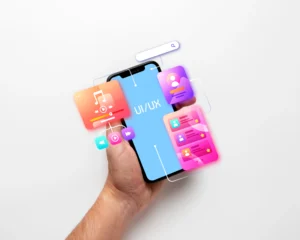Thing to put in Considerations for Developing a Mobile App for Your Business

Introduction
In today’s digital age, mobile applications have become indispensable tools for businesses looking to enhance their online presence and engage with customers on-the-go. With the ever-increasing popularity of smartphones and tablets, mobile apps offer unparalleled opportunities for businesses to connect with their target audience and drive revenue growth.
In this comprehensive guide to mobile app development, we’ll explore the essential prerequisites and requirements for launching a successful mobile app in 2024.
When strategizing for a mobile app for your business, it’s vital to delve into various critical factors at the planning phase. This includes defining the app concept, understanding your target users, and conducting thorough market research. A mobile application that offers exceptional user experience can significantly benefit your business by boosting brand visibility, enhancing operational efficiency, and establishing a direct communication channel with your audience.
What is mobile application development ?

Application development refers to the process of creating software applications that are specifically designed to run on mobile devices such as smartphones and tablets. These applications can be developed for various purposes, including entertainment, productivity, communication, and e-commerce. With the advent of advanced mobile technologies and platforms, such as iOS and Android, businesses now have the opportunity to reach a wider audience and provide innovative solutions through mobile apps.
The Importance of Mobile Apps in 2024
In recent years, the usage of mobile apps has skyrocketed, with millions of users worldwide relying on them for everyday tasks and activities. From ordering food and shopping online to booking appointments and managing finances, mobile apps have revolutionized the way we live and work. For businesses, having a mobile app has become essential for staying competitive in today’s fast-paced market.
Not only do mobile apps provide a convenient way to interact with customers, but they also offer valuable insights into user behavior and preferences, allowing businesses to tailor their offerings to meet the needs of their target audience.
Requirements for Mobile Application Development
Before embarking on the mobile app development journey, it’s crucial to understand the key requirements involved in bringing your app idea to life. From technical specifications to design considerations, there are several factors to consider when developing a mobile app:
Technical Specifications:
One of the first steps in mobile app development is defining the technical specifications of your app. This includes determining the platform(s) on which your app will run, such as iOS, Android, or cross-platform development frameworks like React Native or Flutter. Each platform has its own set of requirements and development tools, so it’s essential to choose the right platform based on your target audience and business objectives.
Design Considerations:
In addition to technical specifications, the design of your app plays a crucial role in its success. A well-designed app not only looks visually appealing but also provides a seamless user experience. When designing your app, consider factors such as user interface (UI) design, navigation flow, and accessibility features. By prioritizing user-centric design principles, you can create an app that is intuitive, engaging, and easy to use.
How to start mobile app development
Once you’ve meticulously defined the technical specifications and intricacies of design for your app, the journey of mobile app development truly begins. It’s an exhilarating phase where ideas start to take shape, and concepts become tangible realities. However, amidst the excitement, it’s essential to maintain a structured approach to ensure smooth progress and successful outcomes.
A crucial first step is choosing the right development approach tailored to your project’s unique needs. Whether opting for native development, cross-platform solutions, or hybrid approaches, each has its merits and considerations. Carefully evaluate factors such as target audience, desired features, budget constraints, and timeframes to make an informed decision.
Defining a development methodology is crucial for streamlining the development process and ensuring project success. Whether embracing Agile methodologies for flexibility and adaptability or following Waterfall methodologies for a more structured approach, establishing clear project management processes is essential. This includes sprint planning, task allocation, progress tracking, and regular communication to keep the project on track.
Creating a detailed project roadmap is indispensable for navigating the complexities of app development. A well-defined roadmap outlines key milestones, deliverables, and timelines, providing a clear roadmap for the development journey. Breaking down the development process into smaller tasks and prioritizing them based on their importance and dependencies helps maintain focus and momentum.
As you embark on building the core features of your app, it’s essential to stay aligned with your project goals and user requirements. Focus on implementing functionality that delivers immediate value to users while setting your app apart from competitors. Embrace an iterative development approach, allowing for continuous testing and refinement throughout the development lifecycle.
Conducting iterative testing is crucial for identifying and addressing bugs, errors, and usability issues early on. Alpha and beta testing with real users provide invaluable feedback, enabling you to make iterative improvements and enhancements to your app. Incorporating user feedback and suggestions into your app’s design and functionality enhances user satisfaction and engagement, ultimately driving the success of your app.
Define Your Project Needs and Goals
Before diving into development, take the time to clearly define your project needs and goals. This includes identifying your target audience, outlining the features and functionality of your app, and setting realistic timelines and budgets for development. By establishing clear objectives upfront, you can ensure that your app development project stays on track and aligns with your overall business objectives
Sketch and Create Your Ideas
With your project requirements in place, begin sketching and creating prototypes of your app ideas. This can be done using wireframing tools or prototyping software, which allow you to visualize the layout and functionality of your app before development begins. By creating prototypes, you can gather feedback from stakeholders and iterate on your designs to ensure they meet the needs of your target audience.
What You Will Need From the App
Consider what you want to achieve with your app. Are you looking to increase sales, improve customer engagement, or streamline internal processes? By clearly defining your objectives, you can prioritize features and functionality that align with your business goals.
Technologies for Mobile App Development

In the ever-evolving world of mobile app development, staying abreast of the latest technologies is crucial for success. From native platforms like Android and iOS to cross-platform frameworks and progressive web apps, a diverse range of technologies empower developers to create innovative and engaging mobile experiences. This guide provides an overview of the technologies driving mobile app development, equipping businesses and developers with the knowledge needed to build cutting-edge mobile applications –
-
Android App Development:
- Utilize Java or Kotlin programming languages for native Android app development.
- Leverage Android Studio, the official integrated development environment (IDE) for Android app development.
- Incorporate Android Jetpack components and libraries to accelerate development and enhance app performance.
- Implement Material Design principles for creating intuitive and visually appealing user interfaces.
-
iOS App Development:
- Use Swift or Objective-C programming languages for native iOS app development.
- Work with Xcode, the official IDE for iOS app development, to build, test, and deploy iOS apps.
- Leverage iOS frameworks such as UIKit, Core Data, and SwiftUI for building rich and interactive user interfaces.
- Adhere to Apple’s Human Interface Guidelines (HIG) to ensure consistency and usability across iOS devices.
-
Cross-Platform Development:
- Consider cross-platform development frameworks such as React Native, Flutter, or Xamarin for building apps that run on both Android and iOS platforms.
- With React Native, use JavaScript and React to build native-like apps with a single codebase.
- Flutter, use Dart programming language and a widget-based architecture to create visually stunning and performant apps across platforms.
- Xamarin, use C# and .NET to build native mobile apps for Android, iOS, and Windows platforms.
-
Progressive Web Apps (PWAs):
- Explore the concept of Progressive Web Apps (PWAs) for developing web applications that offer a native app-like experience on devices.
- Use HTML, CSS, and JavaScript to build PWAs that are responsive, fast, and reliable.
- Leverage service workers and web app manifest files to enable offline functionality, push notifications, and installation prompts for PWAs.
-
Backend Technologies:
- Choose backend technologies such as Node.js, Python, Ruby on Rails, or PHP for building the server-side components of your mobile app.
- Implement RESTful APIs or GraphQL for communication between the mobile app and backend servers.
- Utilize cloud services such as AWS, Google Cloud Platform, or Microsoft Azure for scalable and reliable backend infrastructure.
As the Best mobile app development company in India We provide comprehensive mobile app development services
By leveraging these technologies and frameworks, businesses can develop mobile apps that meet the needs of their target audience and deliver exceptional user experiences across different platforms and devices. Whether opting for native development or cross-platform solutions, choosing the right technologies is essential for the success of your app project.
Proper Market Research

Conducting thorough market research is essential for understanding your target audience, identifying competitors, and uncovering opportunities in the market. Analyze industry trends, consumer behavior, and competitor strategies to gain insights that will inform your app development decisions.
Know How Your App Will Be Different from Competitors
Identify what sets your app apart from competitors in the market. Whether it’s unique features, superior functionality, or a better user experience, highlight the value proposition of your app and communicate it effectively to your target audience.
Need of the Market
Ensure that there is a demand for your app in the market. Conduct market research to identify pain points and challenges that your app can address, and validate your idea with potential users to gauge interest and demand.
Value for Customer from the App
Your app’s value proposition lies in its ability to address specific pain points or fulfill the needs for your target audience. Consider the following subheadings to elaborate on the value your app provides:
Problem Solving
- Identify common challenges or problems faced by your target users.
- Explain how your app offers solutions to these problems, making users’ lives easier or more efficient.
Time-Saving Features
- Highlight features of your app that streamline tasks or processes for users.
- Emphasize how these features save users time and effort, enhancing their productivity and convenience.
Enhanced Convenience
- Showcase how your app simplifies everyday activities for users.
- Illustrate how your app offers convenience by providing access to essential services or information on the go.
Improved User Experience
- Describe how your app delivers a seamless and enjoyable user experience.
- Discuss user-centric design principles implemented in your app to enhance usability and satisfaction.
Personalized Solutions
- Explain how your app offers personalized experiences tailored to individual user preferences.
- Highlight features such as customization options or personalized recommendations that enhance user engagement.
Ultimately, the goal is to demonstrate the tangible benefits of your app to users and convince them of its value proposition. By focusing on solving problems, saving time, enhancing convenience, and delivering personalized experiences, your app can effectively meet the needs and expectations of your target audience, driving user engagement and retention.
Conclusion
Mobile app development is a complex and multifaceted process that requires careful planning, strategic thinking, and a deep understanding of user needs and preferences. By following the essential prerequisites and requirements outlined in this guide, businesses can set themselves up for success and create apps that deliver value to users and drive business growth. Whether you’re a startup looking to launch your first app or an established enterprise seeking to expand your digital presence, investing in app development can open up new opportunities and unlock your business’s full potential in 2024 and beyond.





Leave a Reply